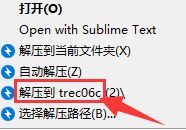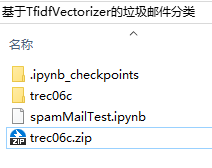基于jieba、TfidfVectorizer、LogisticRegression的垃圾邮件分类
2018年9月27日笔记
jieba中文叫做结巴,是一款中文分词工具,官方文档链接:https://github.com/fxsjy/jieba
TfidfVectorizer中文叫做___ 词频逆文档频率向量化模型,是用来文章内容向量化的工具,官方文档链接:http://sklearn.apachecn.org/cn/0.19.0/modules/generated/sklearn.feature_extraction.text.TfidfVectorizer.html
LogisticRegression中文叫做逻辑回归模型___,是一种基础、常用的分类方法。
建议读者安装anaconda,这个集成开发环境自带了很多包。
到2018年9月27日仍为最新版本的anaconda下载链接: https://pan.baidu.com/s/1pbzVbr1ZJ-iQqJzy1wKs0A 密码: g6ex
官网下载地址:https://repo.anaconda.com/archive/Anaconda3-5.2.0-Windows-x86_64.exe
下面代码的开发环境为jupyter notebook,使用在jupyter notebook中的截图表示运行结果。
0.打开jupyter
在桌面新建文件夹命名为基于TfidfVectorizer的垃圾分类,如下图所示:
打开 基于TfidfVectorizer的垃圾邮件分类文件夹,在按住Shift键的情况下,点击鼠标右键,出现如下图所示。
选择 在此处打开PowerShell窗口,之后会在此路径下打开PowerShell。
在PowerShell中输入命令并运行: jupyter notebook
PowerShell运行命令后,会自动打开网页,点击如下图所示网页中的按钮:
spam中文叫做 垃圾邮件
代码文件重命名为 spamMailTest,重命名按钮位置如下图所示:
1.数据下载
数据文件下载链接: https://pan.baidu.com/s/1kqOFq8Ou_2D3fIKp0l62qQ 提取码: eu5x
压缩文件trec06c.zip当中含有64000多个包含邮件内容的文本文件。
使用软件Winrar无法解压,使用软件7zip或Bandizip可以解压,需要3分钟左右。
选择解压到trec06c,如下图所示:
解压完成后,文件夹中目录结构如下图所示:
2.数据观察
查看文件需要安装Notepad++,安装软件后鼠标右击文件,从Notepad++中打开按钮如下图所示:
trec06c文件夹中的data/000/001文件内容如下图所示。
篇幅有限,本文作者只演示其中一篇邮件的内容。
通过查看多篇邮件的内容,发现 邮件头和 邮件内容以一个空行分隔。
在代码中找到第一个
\n\n分隔成2段,第1段为邮件头,第2段为邮件内容。
trec06c文件夹中的full/index文件内容如下图所示。
每1行按照空格分隔成2段,第1段是邮件是否为垃圾邮件,标签值为spam则是垃圾邮件,标签值为ham则是正常邮件;
第2段是此邮件对应的路径,代码中通过字符串切片和拼接 稍作修改成为能够读取文件的路径。
3.数据准备
3.1 预测目标值
预测目标值赋值给变量y,代码如下:
with open('./trec06c/full/index') as file:
y = [k.split()[0] for k in file.readlines()]
print(len(y))
上面一段代码的运行结果如下:
64620
从上面的运行结果可以看出,共有64620个样本。
3.2 邮件文本文件路径
邮件文本文件路径列表赋值给变量filePath_list。
本文作者使用3种方法获取文本文件路径,读者可以参考。
3.2.1 使用trec06c文件夹中的full/index文件
第1种是直接使用trec06c文件夹中的full/index文件,代码如下:
with open('./trec06c/full/index') as file:
filePath_list = ['./trec06c' + k.strip().split()[1][2:] for k in file.readlines()]
print(filePath_list[0])
print(filePath_list[1])
上面一段代码的运行结果如下:
64620
./trec06c/data/000/000
./trec06c/data/000/001
3.2.2 定义getFilePathList函数
第2种是定义getFilePathList函数,函数中主要使用os.path.listdir、os.path.isdir、os.path.isdir这3个方法,获取根目录下的所有文件。
os.path.listdir方法需要1个参数,参数是路径,参数数据类型为字符串,方法可以找出路径下所有文件夹和文件。
os.path.isdir方法需要1个参数,参数是路径,参数数据类型为字符串,方法可以判断此路径是否为文件夹。
os.path.isfile方法需要1个参数,参数是路径,参数数据类型为字符串,方法可以判断此路径是否为文件。
import os
import time
def getFilePathList(rootDir):
filePath_list = []
fileOrDir_list = os.listdir(rootDir) #列出文件夹下所有的目录与文件
for fileOrDir in fileOrDir_list:
path = os.path.join(rootDir, fileOrDir)
if os.path.isdir(path):
filePath_list.extend(getFilePathList(path))
if os.path.isfile(path):
filePath_list.append(path)
return filePath_list
startTime = time.time()
filePath_list = getFilePathList('./trec06c/data')
print(len(filePath_list))
print(filePath_list[0])
print(filePath_list[1])
print('function use %.2f seconds' %(time.time()-startTime))
上面一段代码的运行结果如下:
64620
./trec06c/data\000\000
./trec06c/data\000\001
function use 24.47 seconds
3.2.3 定义getFilePathList2函数
第3种是定义getFilePathList2函数,函数中主要使用os.walk方法,获取目录下所有的文件。
os.walk方法的返回结果的数据类型是列表,列表中的元素的数据类型是元组。
元组的第1个元素为表示路径的字符串;
元组的第2个元素为第1个元素所表示路径下的文件夹;
元组的第3个元素为第1个元素所表示路径下的文件;
import os
import time
def getFilePathList2(rootDir):
filePath_list = []
for walk in os.walk(rootDir):
part_filePath_list = [os.path.join(walk[0], file) for file in walk[2]]
filePath_list.extend(part_filePath_list)
return filePath_list
startTime = time.time()
filePath_list = getFilePathList2('./trec06c/data')
print(len(filePath_list))
print(filePath_list[0])
print(filePath_list[1])
print('function use %.2f seconds' %(time.time()-startTime))
上面一段代码的运行结果如下:
64620
./trec06c/data\000\000
./trec06c/data\000\001
function use 0.64 seconds
3.2.4 本节小结
对比3.2.2节和3.2.3节的运行时间,使用内置的os.walk方法效率高出很多。24.47/0.64=38.2344,在效率上,使用os.walk方法为自己实现方法的38倍。
3.3 邮件内容
3.3.1 加载邮件内容
本文作者在此项目开发中,采用快速迭代开发策略。
第1个迭代版本丢弃邮件头只使用邮件内容作为特征,就取得98%左右的准确率。
邮件内容列表赋值给变量mailContent_list,代码如下:
mailContent_list = []
for filePath in filePath_list:
with open(filePath, errors='ignore') as file:
file_str = file.read()
mailContent = file_str.split('\n\n', maxsplit=1)[1]
mailContent_list.append(mailContent)
print(mailContent_list[1])
上面一段代码的运行结果如下:
讲的是孔子后人的故事。一个老领导回到家乡,跟儿子感情不和,跟贪财的孙子孔为本和睦。
老领导的弟弟魏宗万是赶马车的。
有个洋妞大概是考察民俗的,在他们家过年。
孔为本总想出国,被爷爷教育了。
最后,一家人基本和解。
顺便问另一类电影,北京青年电影制片厂的。中越战背景。一军人被介绍了一个对象,去相亲。女方是军队医院的护士,犹豫不决,总是在回忆战场上负伤的男友,好像还没死。最后
男方表示理解,归队了。
从上面的运行结果可以看出,获取邮件内容列表成功。
3.3.2 正则表达式去除多余空格
re.sub('\s+', ' ', k)可以把变量k中多个空格或换行替换为单个空格。
import re
mailContent_list = [re.sub('\s+', ' ', k) for k in mailContent_list]
4.分词
4.1 加载停顿词
停顿词文件下载链接: https://pan.baidu.com/s/1JWQFy84wN_jhU9H2P1Ig7g 提取码: uk4m
停顿词文件stopwords.txt文件下载完成后,放在代码文件的同级目录。
with open('./stopwords.txt', encoding='utf8') as file:
file_str = file.read()
stopword_list = file_str.split('\n')
stopword_set = set(stopword_list)
print(len(stopword_list))
print(len(stopword_set))
上面一段代码的运行结果如下:
1233
1231
从上面的运行结果可以看出,停顿词列表中有2个停顿词重复。
4.2 去除停顿词效率对比
jie.lcut(mail)与list(jie.cut(mail))两种写法效果相同。
每篇邮件的分词结果的数据类型为列表,本文作者使用了2种方法去除分词结果中的停顿词。
不去除停顿词的代码写法cutWords = [k for k in jieba.lcut(mail)]
第1种去除停顿词的代码写法cutWords = [k for k in jieba.lcut(mail) if k not in stopword_list]
import time
import jieba
cutWords_list = []
startTime = time.time()
i = 0
for mail in mailContent_list[:3000]:
cutWords = [k for k in jieba.lcut(mail) if k not in stopword_list]
cutWords_list.append(cutWords)
i += 1
if i % 1000 == 0:
print('前%d篇邮件分词共花费%.2f秒' %(i, time.time()-startTime))
上面一段代码的运行结果如下:
前1000篇邮件分词共花费14.74秒
前2000篇邮件分词共花费27.88秒
前3000篇邮件分词共花费43.70秒
第2种去除停顿词的代码写法cutWords = [k for k in jieba.lcut(mail) if k not in stopword_set]
import time
import jieba
cutWords_list = []
startTime = time.time()
i = 0
for mail in mailContent_list[:3000]:
cutWords = [k for k in jieba.lcut(mail) if k not in stopword_set]
cutWords_list.append(cutWords)
i += 1
if i % 1000 == 0:
print('前%d篇邮件分词共花费%.2f秒' %(i, time.time()-startTime))
上面一段代码的运行结果如下:
前1000篇邮件分词共花费5.50秒
前2000篇邮件分词共花费10.37秒
前3000篇邮件分词共花费16.20秒
从上面2种方法运行时间的对比可以看出,判断1个元素是否在集合中比判断1个元素是否在列表中效率要高。
判断1个元素是否在集合中,使用hash算法,时间复杂度为O(1);
判断1个元素是否在列表中,使用循环遍历对比的方法,时间复杂度为O(n)。
在此次分词结果去除停顿词的实践中,使用判断1个元素是否在集合中的方法,效率是判断1个元素是否在列表中的3倍左右。
64000多篇邮件分词去除停顿词共花费350秒左右,即6分钟左右。
4.3 保存分词结果
第1行代码导入pickle库
第3行代码open方法中的'wb'表示文件以二进制形式写入。
第4行代码调用pickle.dump方法将python中的对象保存到文件中。
import pickle
with open('cutWords_list.pickle', 'wb') as file:
pickle.dump(cutWords_list, file)
4.4 加载分词结果
本文作者提供已经完成的分词结果,下载链接: https://pan.baidu.com/s/1bjPgrsXKkovdgbdpzNXOmQ 提取码: x71b
压缩文件cutWords_list.zip下载完成后,其中的文件cutWords_list.pickle解压到代码文件同级目录。
import pickle
with open('cutWords_list.pickle', 'rb') as file:
cutWords_list = pickle.load(file)
5.TfidfVectorizer模型
调用sklearn.feature_extraction.text库的TfidfVectorizer方法实例化模型对象。
TfidfVectorizer方法需要3个参数。
第1个参数是分词结果,数据类型为列表,其中的元素也为列表;
第2个关键字参数min_df是词频低于此值则忽略,数据类型为int或float;
第3个关键字参数max_df是词频高于此值则忽略,数据类型为Int或float。
查看TfidfVectorizer方法的更多参数用法,官方文档链接:http://sklearn.apachecn.org/cn/0.19.0/modules/generated/sklearn.feature_extraction.text.TfidfVectorizer.html
from sklearn.feature_extraction.text import TfidfVectorizer
tfidf = TfidfVectorizer(cutWords_list, min_df=100, max_df=0.25)
6.训练数据准备
模型需要的训练数据是纯数字的特征矩阵和预测目标值。
特征矩阵通过TfidfVectorizer模型获得,预测目标值是标签编码的结果。
6.1 特征矩阵
第1行代码调用TfidfVectorizer对象的fit_transform方法获得特征矩阵;
第2行代码打印查看TfidfVectorizer对象的词表大小;
第3行代码查看特征矩阵的形状。
X = tfidf.fit_transform(mailContent_list)
print('词表大小:', len(tfidf.vocabulary_))
print(X.shape)
6.2 预测目标值
第1行代码导入sklearn.preprocessing库的LabelEncoder类;
第3行代码调用LabelEncoder()实例化标签编码对象;
第4行代码调用标签编码对象的fit_transform方法获取预测目标值。
from sklearn.preprocessing import LabelEncoder
labelEncoder = LabelEncoder()
y_encode = labelEncoder.fit_transform(y)
7.逻辑回归模型
7.1 模型训练
最后1行代码ndarray对象的round方法表示小数点保留位数。
from sklearn.linear_model import LogisticRegressionCV
from sklearn.model_selection import train_test_split
train_X, test_X, train_y, test_y = train_test_split(X, y_encode, test_size=0.2)
logistic_model = LogisticRegressionCV()
logistic_model.fit(train_X, train_y)
logistic_model.score(test_X, test_y).round(4)
上面一段代码的运行结果如下:
0.9791
7.2 模型保存
保存模型需要先安装pickle库,安装命令:pip install pickle
调用pickle库的dump方法保存模型,需要2个参数。
第1个参数是保存的对象,可以为任意数据类型,因为有3个模型需要保存,所以下面代码第1个参数是字典。
第2个参数是保存的文件对象,数据类型为_io.BufferedWriter
import pickle
with open('allModel.pickle', 'wb') as file:
save = {
'labelEncoder' : labelEncoder,
'tfidfVectorizer' : tfidf,
'logistic_model' : logistic_model
}
pickle.dump(save, file)
7.3 模型加载
本文作者提供已经完成的模型文件,下载链接: https://pan.baidu.com/s/1lMbDgxBrGPsXACA_26c75g 提取码: vve6
import pickle
with open('allModel.pickle', 'rb') as file:
allModel = pickle.load(file)
labelEncoder = allModel['labelEncoder']
tfidfVectorizer = allModel['tfidfVectorizer']
logistic_model = allModel['logistic_model']
8.模型评估
8.1 交叉验证
from sklearn.linear_model import LogisticRegressionCV
from sklearn.model_selection import cross_val_score
from sklearn.model_selection import ShuffleSplit
cv_split = ShuffleSplit(n_splits=5)
logisticCV_model = LogisticRegressionCV()
score_ndarray = cross_val_score(logisticCV_model, X, y, cv=cv_split)
print(score_ndarray)
print(score_ndarray.mean())
上面一段代码的运行结果如下:
[0.97833488 0.97756113 0.97384711 0.97709687 0.97709687]
0.9767873723305479
8.2 混淆矩阵
此节代码能够成功运行的前提是先运行7.1节或7.3节的代码。
绘制混淆矩阵的代码如下:
from sklearn.metrics import confusion_matrix
import pandas as pd
predict_y = logistic_model.predict(X)
pd.DataFrame(confusion_matrix(y, predict_y),
columns=labelEncoder.classes_,
index=labelEncoder.classes_)
上面一段代码的运行结果如下图所示:
8.3 报告表
绘制precision、recall、f1-score、support报告表,代码如下:
import numpy as np
from sklearn.metrics import precision_recall_fscore_support
def eval_model(y_true, y_pred, labels):
# 计算每个分类的Precision, Recall, f1, support
p, r, f1, s = precision_recall_fscore_support(y_true, y_pred)
# 计算总体的平均Precision, Recall, f1, support
tot_p = np.average(p, weights=s)
tot_r = np.average(r, weights=s)
tot_f1 = np.average(f1, weights=s)
tot_s = np.sum(s)
res1 = pd.DataFrame({
u'Label': labels,
u'Precision': p,
u'Recall': r,
u'F1': f1,
u'Support': s
})
res2 = pd.DataFrame({
u'Label': ['总体'],
u'Precision': [tot_p],
u'Recall': [tot_r],
u'F1': [tot_f1],
u'Support': [tot_s]
})
res2.index = [999]
res = pd.concat([res1, res2])
return res[['Label', 'Precision', 'Recall', 'F1', 'Support']]
eval_model(y, predict_y, labelEncoder.classes_)
上面一段代码的运行结果如下:
9.结论
本文是作者第3个NLP小型项目,数据共有64000多条。
经过交叉验证,模型平均得分为0.98左右。
最后在全部样本的f1-score指标为0.98,总体来说这个分类模型较优秀,能够投入实际应用。








